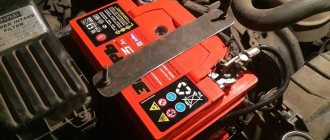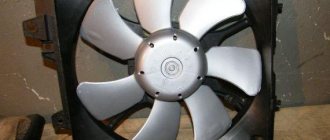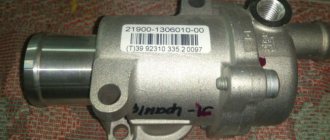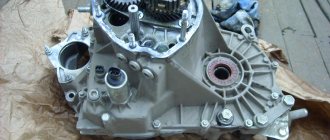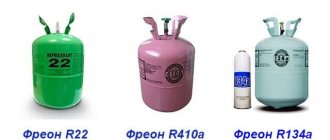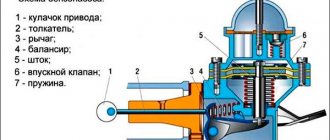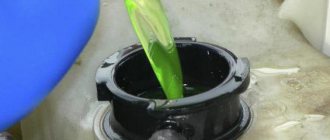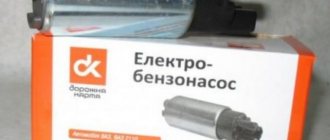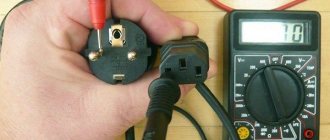In the process of servicing cars, owners have to periodically change some consumables, as well as check their current condition. This makes it clear whether it is time to drain this or that liquid, or whether it can still serve normally for some time.
Antifreeze can easily be considered one of the most important fluids in a car. It is also coolant or simply coolant.
In addition to draining and replacing antifreeze, motorists often check the density. Not everyone understands why to do this and how to perform such a procedure.
Coolant for cars
Antifreeze (antifreeze) in a car radiator performs two main functions:
- protects the engine from overheating during operation;
- prevents freezing of coolant at subzero ambient temperatures in winter.
Antifreeze is produced by industry according to international standards; there are classes G13, G12, G12+ and G11. As a rule, G11 antifreeze is colored blue or green and freezes at a temperature of about -40ºC. Compositions G13 and G12 are usually concentrated and do not lose their properties up to minus 80 degrees Celsius.
Antifreeze is essentially the same antifreeze, only produced for Russian cars. There are three types of this coolant - A40, A65 and AK (concentrated composition), respectively, A40 antifreeze freezes at a temperature of -40ºC, grade A65 - at -65ºC. In any case, the concentrate must be diluted with water; when mixing the two components in a 1:1 ratio, the coolant will crystallize at 30 degrees below zero.
Useful tips
As experts advise, if antifreeze is purchased in the form of a concentrate, after pouring the finished liquid into the cooling system, be sure to measure the density of such a composition. If you purchased ready-made antifreeze or antifreeze, you must immediately measure its density before pouring it into the system.
The fact is that there are a large number of counterfeits of well-known brands of coolants on sale (Shell, Liqui Moly, Bizol, etc.). Simply put, there is no ethylene glycol/propylene glycol. Instead of the base, acids and sugar and salt are used.
The danger of such products is that initially measuring the density may show the norm, and the liquid will not freeze in the cold. However, after a short period of time after heating and cooling, the fake antifreeze will lose its properties and freeze in slight frost with all the ensuing consequences.
To avoid such risks, it is better to check the density of the liquid again a couple of days after replacing the antifreeze. If there are obvious changes in the direction of decreasing density, then it is a fake. It is urgent to drain such antifreeze, thoroughly flush the entire cooling system and refill with a high-quality original product.
In practice, it is ready-made antifreeze (already mixed with water) that is most often counterfeited, but similar manipulations with the concentrate also cannot be ruled out. For insurance, we can recommend purchasing antifreeze, antifreeze and other technical fluids exclusively at official or verified points of sale.
Checking the density of antifreeze with a hydrometer
It is most often necessary to measure the density of antifreeze (antifreeze) before winter, when it is necessary to top up or replace the coolant - it is important that it does not freeze at any negative air temperatures. You can measure the density of antifreeze with a hydrometer; when obtaining the result, you should be guided by the data in the table. Under no circumstances should measurements be carried out on a hot engine:
- there is a risk of getting burned by the coolant;
- the results obtained will be inaccurate.
You can measure the density not only of the coolant that is in the radiator, but also of antifreeze purchased in a store - it is possible that ethylene glycol was diluted with more water than prescribed. To check the density you will need:
- container with coolant;
- hydrometer for electrolyte and antifreeze;
A special hydrometer has two scales; to measure the density of the electrolyte, the measuring device has markings for density and freezing temperature.
We check antifreeze bought in a store like this:
- unscrew the cap on the canister;
- We collect coolant into the measuring device flask.
The flask must be filled with antifreeze in sufficient volume; with a small amount of coolant, the readings may be incorrect. It is also necessary that the float floats in the liquid.
For accurate measurement, you should shake the hydrometer - this must be done so that air bubbles come out of the coolant and the float does not stick in the flask.
If the coolant, according to the hydrometer readings, corresponds to the norm, it can be poured into the radiator, but it does not hurt to check the antifreeze for its authenticity. There are often cases when a dishonest manufacturer adds sulfuric acid to the coolant to increase density. This component is very harmful to the cooling system; it corrodes the walls of the cylinder head and cylinder block from the inside. Checking for the presence of sulfuric acid in antifreeze is very simple:
- pour coolant into the container;
- add soda to it.
If a reaction occurs (antifreeze hisses), then acid has been added. The absence of any reactions indicates that the antifreeze is normal.
Measurements with a hydrometer should be made at a coolant temperature of plus 20 degrees, so it would be a good idea to use a thermometer here. Measuring density directly in the cooling system is carried out with the hydrometer partially immersed in the radiator (installed in the filler neck) or in the expansion tank. You can also carry out a secondary check after five to seven days of using the car, and if necessary, adjust the density of the antifreeze by adding distilled water or concentrate, depending on the readings obtained.
Counterfeit, how to detect?
When purchasing a coolant in a store, it is not possible to determine a low-quality coolant using a hydrometer. It has already been noticed that scammers prepare a technical solution using low-quality water, acids, sugar, salt, excluding ethylene glycol. That is, when measured by the device, the density indicator of antifreeze will have a normal value.
The main problem with low-quality coolant is time - as time passes, it loses its properties. A couple of weeks is enough for the counterfeit product to lose its useful cooling properties.
To check the quality of the coolant, you must first test it with a hydrometer. If the value is at a normal level, then the solution can be poured into the car and driven for 7 days. After a week, you should retest the antifreeze density:
- the readings remained at the same level - everything is in order;
- slight deviation from the norm - should be rechecked after 7 days;
- significant change - it is necessary to drain the cooling component and add a new portion.
Running a vehicle on counterfeit antifreeze will quickly damage the vehicle's propulsion system.
Antifreeze density table, dependence of freezing temperature on coolant density
Many car enthusiasts periodically have difficulties with the density of antifreeze. This occurs due to a coolant or antifreeze leak. Some car owners simply add water in the summer, which freezes in the winter and disrupts the system. To avoid such problems, you need to be able to use an antifreeze density table and a hydrometer to measure it.
Checking the density of antifreeze with a refractometer
Unlike checking with a hydrometer, measuring coolant density with a refractometer is very fast, and one drop of antifreeze is enough to measure.
You can check the coolant in any condition; the temperature here does not affect the readings obtained. The measurement procedure is as follows:
- using a pipette, place a drop of the tested antifreeze on the prism of the device;
- We focus using the reflectometer eyepiece;
- We read the readings from the value scale (along the dividing line).
The device is adjusted using distilled water; when testing it, the bar in the eyepiece should be at the very bottom of the scale, that is, at zero. If the device is not adjusted accurately, it is adjusted with a screw located under the protective cap. The refractometer kit includes a screwdriver, pipette and spatula.
How to spot fake antifreeze
When purchasing, it is almost impossible to determine the “wrong” antifreeze, even with the help of a hydrometer. Recently, scammers have been actively using acids, sugar, and salt to dilute with water and create “antifreeze,” instead of the necessary ethylene glycol. Accordingly, when measuring such mixtures with a hydrometer, their density will be at the correct level.
The problem is that counterfeit antifreeze, unlike real antifreeze, loses its properties faster during operation. That is, it is enough for it to work in the coolant cycle for several weeks - constantly heating and cooling - and it will become unusable.
To ensure the quality of antifreeze, you must first check it with a hydrometer. If the indicator is normal, the liquid can be poured into the car and driven for a week. After a week, you need to take the liquid from the radiator with a hydrometer for density analysis:
- If the indicator has not changed, everything is fine;
- If the change is insignificant, repeat the check in a week;
- If it has changed significantly, you need to drain the antifreeze and add new one.
Operating a car with counterfeit coolant will quickly lead to engine failure.
(443 votes, average: 4.51 out of 5)
Checking the density of antifreeze using the traditional method
In many modern refrigerators, the temperature in the freezer compartment is adjustable; you can set its minimum value to -24ºC. You can approximately check the density of antifreeze here as follows:
- pour a small amount of coolant (50-100 grams) into a plastic bottle and seal it tightly;
- place the container in the freezer for one hour.
If the antifreeze has not crystallized, it means it can withstand this temperature and will not freeze in the radiator in such frost.
Differences between hydrometers by purpose
Despite the fact that almost all hydrometers are used to measure density and operate on the same principle, they can have different purposes, which must be taken into account when choosing a device. According to existing state standards, density meters are divided into the following types:
- General purpose devices.
- Densimeters for electrolyte. Serves to control the density of the acid electrolyte in the battery.
- For petroleum products. They are used to measure the quality of petroleum products.
- Alcohol meters. Shows the quantitative alcohol content in alcoholic drinks.
- Lactometers. Allows you to determine the fat content and other characteristics of milk.
- Medical. To check the specific density of urine during laboratory tests.
- Sugar meters. Allows you to measure the amount of sugar in a liquid.
- Salt meters. Used to control water hardness.
How do these devices differ from one another? According to the principle and methodology of measurement, as noted above, nothing. The main difference is the measured density range and scale graduation. An alcohol meter, for example, measures density in the range of 0.79–0.99 g/cm. cubic, and the type of hydrometer for electrolyte is 1.1–1.4 g/cm. cube Thus, the first one will float freely on the surface of the electrolyte, the second one will drown completely in alcohol. In addition, the alcohol meter scale is usually graduated in percentage volume ("degrees"), and the density of the electrolyte is measured in grams per cubic centimeter or kilograms per cubic meter.
The alcohol meter (above) is graduated in percentage, and the hydrometer scale for electrolyte is expressed in kg/m. cube
The same problems will arise with other types of devices if you try to use them for other purposes. The only exception may be a universal density meter. As a rule, it has a very large measurement range, and its scale is calibrated in standard density units - g/cm. cube (kg/m3).
We recommend: How to properly remove the battery from a car
Checking the density (concentration) of antifreeze using a hydrometer
Any car owner wants the coolant he purchases to actually correspond to the characteristics indicated on the sticker. But according to recent studies, the proportion of counterfeit products sold on the market is more than 50 percent. Despite the attractive plastic container and bright labels on it, there may only be a liquid inside that looks like antifreeze or antifreeze, made in Russia or abroad. What a hydrometer for antifreeze is is what we will discuss in our article.
There is no guarantee that the inside of the container is not ordinary water with unknown additives, and there is no natural antifreeze or antifreeze. So what's the solution? How to check the quality of a purchased product? It is for these purposes that such a simple device as a hydrometer is used, with the help of which any car owner can check what they are offered to purchase. You can also use it to check the condition of the liquid that is already poured into the system. Based on the realities of today, we recommend that every driver have such a device, and we will tell you how to use it below.
The process of pouring coolant into the tank
What determines the volume of antifreeze
Antifreeze density.
how to check and what should it be? a few words about antifreeze Several factors exert pressure on the coolant level, the main ones being:
- the integrity of the condition of the gasket, the cylinder head itself, the radiator, the expansion tank, the stove, the corresponding tubes, hoses;
- correct fixation of hoses with clamps of the appropriate diameter;
- proper functioning of the radiator and tank valves;
- defect-free condition of the outlet;
- normal operation of the fuel ignition system;
- selection of antifreeze brand
When there are any defects in the cylinder head, the block itself or the gasket, then coolant will leak either into the cylinders or into the oil. In the first option, the exhaust gases will have a white tint even at high air temperatures. In the second case, the oil will look like a thick, bubbly suspension.
In a situation where the gasket is broken, both signs appear simultaneously. In addition, the car owner will invariably note increased fuel consumption, as well as a significant decrease in engine power.
If the radiator or expansion tank valves are damaged, then the boiling point of the antifreeze will decrease, therefore, air or vapor locks are inevitable. This can be caused by the formation of blockages in the outlet or hoses of the tank, since the antifreeze will not be able to get to the radiator and engine.
When the fuel system produces a lean air-fuel mixture, detonation and heat emissions will increase significantly. This will lead to rapid boiling of the antifreeze with the simultaneous formation of vapor locks.
If, on the contrary, the mixture is over-enriched, then in order to provide the necessary engine power, the car owner will have to press the gas pedal with additional force. As a result, the cylinders are filled with excess fuel, the temperature rises, and the coolant boils.
What is an antifreeze hydrometer?
A hydrometer is a very simple device for checking the quality of coolant, similar to a fishing float. It provides a special scale on which you can check the density of the electrolyte and in degrees of antifreeze and antifreeze. Using a rubber bulb located at the top of the device, antifreeze, antifreeze or electrolyte is sucked into the pipette. The contact of the coolant or electrolyte with the hydrometer rod shows the density of the liquid being tested in kg/dm3 or the freezing point in degrees. For the readings to be accurate, measurements must be taken at an ambient temperature of about 20°C.
Components of a hydrometer
Device
This device is designed very simply. There is a special scale with risks at the top. There is also a rubber bulb placed on the top of the device. Below is a pipette for collecting liquid.
Principle of operation
The principle of operation of the device is based on the well-known law of Archimedes, which we all remember very well from school. This video shows the principle of operation of a hydrometer and explains how to use it.
Hydrometer design for electrolyte
How to check the density of battery electrolyte?
The automotive version of the device includes:
- hydrometer-densimeter,
- glass tube with tip,
- rubber bulb.
A tip is immersed into the battery filler hole, through which, using a bulb, the electrolyte is drawn into the glass tube until the hydrometer float floats to the surface. Moreover, during measurements, it is necessary to ensure that the hydrometer does not touch the bottom and walls, and the flask must be held vertically.
Another type of motorist's hydrometer is a set of floats of different masses, but of the same volume, placed in a glass container. Each has only one mark. When filled with liquid, some of the floats will sink, and the floating float with the highest indicator shows the real density of the liquid.
It is the density and concentration of the electrolyte that determine performance no less than the electrodes. Therefore, their values must be regularly monitored.
Every vehicle owner wants the battery to last as long as possible. And if the resource of maintenance-free batteries is limited by the manufacturer, then serviced power supplies with proper service can outlive the car. One of the most important indicators is the density of the electrolyte. To control it, you need to know how to properly use a battery hydrometer - a device that allows you to measure the degree of acidity of the solution in the battery cells.
Density is the weight of sulfuric acid mixed with water relative to the entire volume of the solution; in other words, it is the degree of acidification of this mixture. The law of hydrostatics states that when a body is immersed in a liquid medium, its weight is equal to the mass of the displaced volume. This simple device works on the basis of this principle, allowing you to determine the acidity of the mixture in g/cm3 with an accuracy of hundredths of a value.
Structurally, a hydrometer for a battery has the form of a glass float with a measurement scale located inside. In many models it is placed in a transparent flask (pipette) made of glass or plastic. This simplifies the fluid collection procedure as much as possible. When using some types of hydrometers, it is possible to measure not only the acidity, but also the temperature of the antifreeze. When fully assembled, the entire structure consists of the following parts:
- Hydrometer;
- Pear;
- A glass pipette into which the device itself is placed;
- Tight cork;
- Fence.
Safety precautions
When working, you need to be careful. If you are checking the quality of coolant that is already in the car system, then turn off the car and wait several hours before checking. The coolant must cool down. If you unscrew the radiator cap immediately after a trip, you risk getting burned.
Also remember that many fluids in a car, such as electrolyte, are acidic and can cause burns if they come into contact with the skin. If this does happen, immediately rinse the burn area with clean water and go to the clinic. If electrolyte gets on your clothes, soak them in water immediately, but most likely the stain will remain on the fabric.
Detectable problems
One of the advantages of a hydrometer is the safety of measuring the density of liquids with an accuracy of 0.05-0.1%.
In addition, this method does not require a large amount of substance to measure. The battery in a car performs its job properly with the following electrolyte reading: at a temperature of 25 degrees 1.28 g/cm3. New batteries with proper certification have similar results in values.
If the readings on the density of the electrolyte in one of the battery cans are lower, this indicates a short circuit: the closure of the lead plates and, as a result, breakdown of the battery.
If the density is below normal throughout the battery, this may indicate problems such as:
- Severe discharge of the battery, reducing its performance.
- One of the stages of sulfation (decomposition of sulfuric acid) has occurred.
- The battery was subject to severe wear and tear due to the constant operation of the engine only on it.
- The battery is old and needs to be replaced.
- Defective battery.
- The battery is an unreliable fake.
If the electrolyte density readings are incorrect, the problems should be corrected. It is worth remembering that if the density is low in only one of the cans, the battery cannot be corrected and should be replaced.
Additional voltage measurements with and without load will help determine the exact cause of the problem.
Tips and tricks
In order to maintain the reliability of the hydrometer readings, you must follow some rules:
- It is recommended to carefully select the clothing in which the test will be carried out. Acid contact with the skin leads to burns, so it is highly undesirable to neglect safety precautions. If acid comes into contact with clothing, it can render it unusable.
- If you do not hold the hydrometer correctly during testing, the float may get stuck, thereby distorting the readings. You need to keep it in an upright position so that it does not touch the glass.
- After measuring the density of the electrolyte, be sure to rinse the hydrometer with water to remove acid residues so that they do not corrode the elements of the device.
- The lower the density in a fully seated device, the longer it will work.
Why is verification so important?
Regularly checking the electrolyte density will help to anticipate and resolve problems with the device. Over time, the battery will work worse than on the first day after purchase. Therefore, you should look after him and monitor him, then he can live up to 10 years.
The electrolyte density in winter should be 1.27 g/cm3. A lower indicator affects the operation of the device, the car will be more difficult to start, sometimes leading to freezing of the electrolyte.
Using a low-charge battery at low temperatures may cause the lead plates to deteriorate. The density can also be determined by checking the density: the lower the density, the more discharged the battery.
This is interesting: How to make a manual potato hiller with your own hands - we cover it carefully
Checking the quality and density of antifreeze at home
When examining the appearance of the cooling solution, first of all you need to pay attention to its color. The color of the emulsion must be a rich natural shade and comply with the characteristics reflected in the regulatory documents.
The second significant sign of a good quality product is the absence of oil stains and inorganic inclusions on the surface of the liquid.
The freezing temperature threshold of the mixture can be determined using special instruments - a hydrometer or a refractometer. The first determines the alcohol content in percent, the second records the crystallization temperature in degrees Celsius.
Hydrometer design
A hydrometer is a special device used to analyze the density of liquid substances. The device consists of a sealed glass flask with a measuring scale, the internal space of which is filled with lead shot.
The amount of metal chips is a calculated value depending on the type of liquid being tested. The device is configured (calibrated) by specialists to work only with a specific substance.
The operating principle of the device is based on Archimedes' law. A body immersed in a liquid is subjected to a buoyant force equal in magnitude to the specific gravity of the mixture in question. Different solutions have different density values, which means the hydrometer will float differently.
In some liquids the float may sink, while in others it will move along the surface at different distances from the watershed boundary (device scale). Therefore, if you need to study the density of antifreeze, then this particular reagent should be specified when purchasing the device.
Refractometer Review
A refractometer is another device for measuring the density of antifreeze. The operating principle of the device is based on the deflection (refraction) of a light beam when passing from one aqueous medium to another. The magnitude of the refraction angle depends on the temperature of the medium and the chemical composition of the emulsion.
The device consists of the following parts:
- polymer body;
- refractometer with glass prism;
- pipettes;
- adjusting screwdriver;
- napkins.
The refractive index depends on the consistency and physicochemical properties of the liquid being tested.
As the initial concentration of the solution increases, the degree of curvature of the light beam increases. The greater the bending angle, the higher the antifreeze density parameter.
Measuring antifreeze density without instruments
There are two ways to measure the density of automotive coolant:
1). Pour antifreeze into a wide and tall glass vessel (glass, test tube, etc.). Immerse the hydrometer in the liquid. Wait for the float to float up. Determine the density of the solution using the instrument scale. During the experiment, you need to control the position of the device in the container; it should not touch the walls of the glass.
2). Pipette a drop of distilled water onto the refractometer prism. Bring the eyepiece to your eye. The number divisions will be visible in the lens, and part of the scale will be colored blue. The line at the interface between light and dark colors will serve as an indicator for measuring density.
The demarcation line, in the case of clean water, should point to zero on the instrument scale. Now, if water is replaced with antifreeze, then this value will change upward (above 0°C). The result obtained will be an indicator of the quality of the liquid.
How to use an optical refractometer?
The sequence of actions performed depends on the type of refractometer. With an analog refractometer, the sample is placed on a lid and prism and then held up to the light to view a scale that is located inside the housing.
Digital refractometers require that a drop of the test solution be placed in a special well. This well is illuminated by a light source, usually an LED, and the measuring device interprets the light transmittance into a refractive index or whatever unit of measurement the device is programmed to read.
To obtain the result, it is enough to place 2...4 drops of the test liquid in the prism or well and secure the lid - this will increase the accuracy of the measurement, since the liquid will be more evenly distributed over the prism. Then (for an optical device) you should point the prism section of the refractometer at the light source and focus the eyepiece until the scale is clearly visible.
The scale is read at the point where the dark and light areas meet. For a digital refractometer, the desired result is displayed after a few seconds on the display screen.
The reference temperature for measurements is considered to be 200C, although automatic compensation is designed for the range 0...300C. The length of the refractometer does not exceed 160…200 mm. It should be kept dry and clean.
An antifreeze refractometer is suitable for determining the concentration of lubricating oils if their refractive indices are within the technological range of this device. To do this, first prepare a Brix diagram and convert the obtained values into an indicator of the density of the measured medium.
How not to buy a fake
High-quality antifreeze has the required amount of special additives and density specified at the factory. All this provides reliable protection for the car engine from sudden temperature changes.
Even at low values exceeding the recommended values, the solution, in case of freezing, will turn into a plastic jelly-like mass and will not damage the structural elements of the motor.
If, instead of a conditioned liquid, a counterfeit is poured into the cooling system, then when the temperature drops below 0°C, such a mixture will expand and increase in volume. Having reached a critical threshold, frozen antifreeze will tear the cooling jacket, radiator and engine water pump.
Refractometer design and preparation for work
The device consists of the following parts:
- Durable plastic housing.
- The actual refractometer.
- Cleaning wipes.
- A set of suction tubes (usually three)
- Calibrating screwdriver.
The versatility of the refractometer is ensured by the ability to perform the following measurements:
- By measuring the freezing point temperature of automotive antifreeze based on ethylene glycol or propylene glycol.
- Determining the specific gravity of battery acid and obtaining operational information about the state of charge of the battery.
- By measuring the composition of an ethanol or isopropyl alcohol based windshield washer fluid.
Readings are taken using scales, each of which is intended for a specific type of liquid. The antifreeze refractometer needs to be calibrated before first use. For this purpose, tap water is used, for which the scale indicator should be at 0.
BEHIND THE STEEL
Having chosen and purchased an antifreeze fluid for the cooling system, every car enthusiast wants it to actually have the properties stated on the label.
According to recent studies, the share of counterfeit products in the antifreeze liquid market ranges from 40 to 50%. Despite the nice plastic container and neatly made stickers on it, there may be a liquid inside that only vaguely resembles domestic antifreeze or foreign antifreeze. Where is the guarantee that the inside of the canister is not colored water, flavored with battery electrolyte, or water with added sugar or salt?
Why is counterfeit dangerous?
What happens to antifreeze (or antifreeze) poured into the cooling system when its temperature drops to the value (for example, -40 0 C) indicated on the packaging? It crystallizes and the antifreeze loses its fluidity, turning into a kind of jelly. At the same time, it does not increase in volume, therefore it does not put pressure on the internal walls of the radiator and the “jackets” of the cooling system.
The picture is completely different if instead of a non-freezing liquid in the cooling system there is a counterfeit made from ordinary water. Having reached zero temperature, the water freezes, noticeably increasing in volume, and since the cooling system is conditionally sealed, the resulting ice simply crushes and breaks the radiator channels, water pump and engine cylinder block.
Even if the counterfeit antifreeze still contains some part of ethylene glycol and it does not freeze but crystallizes as the temperature drops, it is unlikely that the counterfeiters bothered to add special anti-corrosion additives to its composition that envelop the non-freezing liquid with a protective film.
Consequently, an aggressive liquid, which is a mixture of water and alcohol, will immediately begin to corrode parts of the engine cooling system. It is unlikely that the engine will withstand at least one season of operation in such conditions.
It is almost impossible to check the presence of protective additives at home, but anyone can find out whether an antifreeze liquid can cope with the cold.
Litmus paper
By moistening the litmus paper with the coolant, the quality of which needs to be determined, and then comparing the color it acquires with a special color scale, it will not be difficult to determine its pH with sufficient accuracy.
If there is no such scale, it doesn’t matter; the approximate acid-base balance of antifreeze can be determined “by eye.” Coloring litmus pink will indicate that there is an excess of acid in the liquid being tested (pH ranges from 1 to 5), and this is direct evidence of counterfeiting.
The blue color of litmus paper will indicate a pronounced alkaline environment with pH > 10, therefore such antifreeze or antifreeze is also a fake, and of disgusting quality.
If the litmus turns green, you know that this is a decent quality antifreeze with an acid-base balance of pH ranging from 7 to 9.
In addition to measuring the density of the electrolyte, modern aerometers can determine the freezing point of antifreeze. Such hydrometers have a scale graduated in degrees next to the density scale.
Having collected antifreeze or antifreeze into the hydrometer using a rubber bulb, it is necessary to determine the line of contact of the tested liquid with the hydrometer rod. Finding a line in the area of the green scale will indicate the crystallization temperature of antifreeze in the range from -30 to -40 0 C. If the indicator points to the red scale, then the coolant has partially lost its properties and will begin to crystallize at a temperature from -20 to -30 0 C. The yellow scale corresponds to the temperature range from -10 to -20 0 C. If the tested liquid in the hydrometer comes into contact with the hydrometer rod in the area of the blue scale, such antifreeze should be replaced immediately, since it has become completely unusable and will behave like ordinary water.
Test freezing
Having collected 100-150 ml of the test liquid into a small plastic bottle, you need to squeeze the bottle a little before tightening the cap, releasing the air from it - suddenly the antifreeze turns out to be fake and after freezing it will crush the plastic container.
After placing the bottle of liquid in the freezer and waiting 1-2 hours, you need to remove the prototype and study it. The temperature in the freezer reaches about -35 0 C, so if the liquid under study has not frozen and has not undergone crystallization at this temperature, it is guaranteed to withstand even more severe frosts, ensuring reliable and stable operation of the engine in winter.
Did you like the article? Subscribe to the channel to stay up to date with the most interesting materials
Verification methods
There are several options for checking the density of antifreeze with your own hands. Moreover, such procedures are easy to perform at home or in the garage.
Before measuring the current density of antifreeze, you should decide on the method used. Each of them requires the presence of certain devices.
To check the current density of antifreeze at home, you can use:
- hydrometer;
- refractometer;
- folk methods.
With such measurements of the density of antifreeze, the motorist will find out the current state of the liquid and decide on further actions with it.
Hydrometer
The easiest way to check the current density of filled or purchased antifreeze is with a hydrometer.
This is an affordable measuring device that clearly reflects the density values of automotive antifreeze. You can purchase it at any auto parts store. The purchase will cost an extremely modest amount.
The main reasons for the loss of antifreeze
- Leaky sealed expansion tank.
Such reasons for antifreeze leaving the expansion tank are the result of driver inattention. A loose expansion tank cap will not be able to contain the pressure in the cooling system, so when the engine heats up, antifreeze will leak through it.In winter, the leakage of coolant through a poorly tightened tank cap will be indicated by the appearance of steam in the area of the main radiator grille (antifreeze evaporates and forms a white haze). In this case, you can eliminate the loss of antifreeze by tightly tightening the cap of the expansion tank of the cooling system.
- Defects in the antifreeze tank.
The expansion tank body is made of plastic. It can be damaged by a metal tool if repair work is not carried out carefully. If a small “hole” is located above the coolant level, then it may not be noticed.The defect appears during the operation of the car. When heated, the coolant expands, therefore, its level rises and it flows out of the reservoir. After the engine cools down, the antifreeze level drops and the fluid must be added.
You can find where the coolant is leaking by visually inspecting the expansion tank. A damaged tank should be replaced, since after soldering the plastic, the antifreeze flow resumes after some time (during engine operation, a fairly high pressure is created in the tank).
- Cracks and other defects in tubes, hoses and their attachment points to the main radiator.
The pipes and hoses of the vehicle's cooling system are constantly exposed to aggressive substances, temperature and pressure changes. Oil and other technical fluids from various vehicle systems, getting on pipes and rubber hoses, contribute to their destruction. In this case, the damage may not be noticeable upon visual inspection, but antifreeze will leak through it. As a result, after some time the coolant level will drop and it will need to be topped up.This reason for the loss of antifreeze can be eliminated only by replacing damaged pipes and hoses.
- Coolant level too high.
The upper mark of the antifreeze level on the expansion tank is located so that the liquid fills half of its volume.At this level, excess pressure will not be created in the tank when the antifreeze expands (otherwise the tank may burst).
In addition, car designers have provided a hole in the tank for overflowing coolant when its level critically increases. To prevent antifreeze from escaping through the overflow hole, you need to fill it in such a way that the level is no higher than the maximum mark.
- Damage to the radiator of the cooling system.
Hot antifreeze is cooled in the radiator of the cooling system, which is located in the front part of the engine compartment of the car. When a car moves at high speed, small stones, dirt and dust can fall onto the radiator along with air flows.It happens that a rapidly flying stone damages the radiator honeycombs and antifreeze begins to leak through them. The rate at which coolant leaves the radiator depends on the size and nature of the damage.
- Engine.
Experts consider antifreeze getting into the engine combustion chambers as the most unpleasant malfunctions. It is in this case that white smoke with a sweetish odor may come out of the exhaust pipe. This sign indicates that the coolant is burning along with the fuel-air mixture.A whitish coating on the dipstick for checking the oil level indicates that antifreeze has entered the engine. In this case, car repairs must be performed by qualified technicians using special equipment.
In order to promptly detect the loss of coolant, experts recommend looking under the hood of your car more often. The sooner a fault is detected, the less money and time it will take to fix it. An insufficient level of antifreeze leads to overheating of the engine, which may result in a major overhaul.
What should this value be for antifreeze and antifreeze?
Antifreeze is a type of coolant, which means it is also antifreeze. Thus, their performance should be similar. The density of antifreeze and antifreeze is on average 1.10 g/cm3. It varies from 1.034 to 1.112 g/cm3. At the first indicator, the liquid will begin to crystallize already at -10 degrees Celsius, at the second - at -20. And this is the entire range of antifreeze, someone might ask? No, oddly enough, with average values - from 1.083 to 1.082 - it will provide protection down to minus 60-65 degrees Celsius. This is the arithmetic.
By the way, for comparison, the density of water is 0.9982 g/cm³. At first glance, the difference is small. But it is she who will determine when and at what temperature the liquid poured into the cooling system will boil and solidify.
Table of the relationship between coolant density and antifreeze concentration
| Coolant temperature (°C) and specific gravity (g/cm3) | Temperature (°C) | Antifreeze concentration (% volume) | |||||
| 10°C | 20°C | 30°C | 40°C | 50°C | Freezing liquid | Safe Operation | |
| 1,054 | 1,050 | 1,046 | 1,042 | 1,036 | -16°C | -11°C | 30% |
| 1,063 | 1,058 | 1,054 | 1,049 | 1,044 | -20°C | -15°C | 35% |
| 1,071 | 1,067 | 1,062 | 1,057 | 1,052 | -25°C | -20°C | 40% |
| 1,079 | 1,074 | 1,069 | 1,064 | 1,058 | -30°C | -25°C | 45% |
| 1,087 | 1,082 | 1,076 | 1,070 | 1,064 | -36°C | -31°C | 50% |
| 1,095 | 1,090 | 1,084 | 1,077 | 1,070 | -42°C | -37°C | 55% |
| 1,103 | 1,098 | 1,092 | 1,084 | 1,076 | -50°C | -45°C | 60% |
Electrolytic corrosion is a “disease” of metal surfaces
The level of protection of the metal parts of the car cooling system from electrolytic corrosion, which can be caused by dirty, long-used antifreeze, or a poorly manufactured product, is shown by an electronic multimeter .
One of its probes must be lowered into the coolant poured into the radiator, and the second one must be grounded by attaching it to any metal surface.
If the device shows less than 150 mV , this means that the antifreeze is clean and ready for use for some time. Indicators above 150 mV indicate that the liquid has already developed protective lubricating and anti-corrosion additives. 300 mV or more indicates the need to urgently change the antifreeze.
Subtleties of choosing antifreeze
If you have problems choosing antifreeze, first study the manufacturer's recommendations. The specification clearly indicates the brand and class of coolant that should be used in your car model. If original products are too expensive for you, then you should take a closer look at analogues. The first selection criterion is the novelty of the car. For cars produced before 1996, use G11. From 1996 to 2001, a G12 class cooler is suitable
In models after 2001, fill in G12+ and G13. Additionally, when purchasing, we recommend paying attention to a number of aspects:
- there should be no sediment at the bottom of the container;
- the packaging must have a high-quality label and no traces of tampering;
- antifreeze does not have a pungent odor;
- buy products with a pH value of 7.4-7.5;
- The cost of the product must be comparable to the market price.
Among the products there are several already established manufacturers. HEPU has an almost impeccable reputation. The company produces high-quality coolants with a wide range of additives. An alternative option is to take products from Febi. In stores you can buy compositions from Felix and domestic ones. Before purchasing, be sure to read all the markings on the label, since the color of the composition does not always characterize its class. It is recommended to regularly check the color saturation of the antifreeze in the car. A change in color indicates that the liquid has lost its properties and therefore requires replacement. Knowing the ins and outs of coolant selection makes your purchase smart, safe, and targeted.
Determination methods
There are several most accessible ways to check how strong a drink is. The most common of them include: refractometric method; determining the number of degrees using a wine meter and a hydrometer.
Refractometric method
As practice has shown, the strength of the drink produced depends on the amount of sugar in the recipe or on the level of its content in the original raw materials. The connection is direct and has a well-known mathematical expression. If you find out how much sugar is contained, then calculating what the strength of the wine will be is not difficult. The number of degrees obtained during fermentation correlates with the level of sugar content of the original wort as follows: 1 to 0.6.
Thus, we find that one percent of sugar will give approximately 0.6 percent or degrees of alcohol in the final product.
Therefore, in order to prepare dry wine drinks at home, it is necessary to achieve a sugar content in the wort of at least 24 percent.
But it is possible to determine the level of sugar content of the wort only using a complex refractometric method, which requires not only the qualifications of a chemist, but also the presence of a device - a refractometer. In the practice of home winemaking, another, very accessible method of determining the strength of drinks is used. https://www.youtube.com/embed/9ZG-CgOTF6Q
Determination by vinometer
You can purchase an inexpensive, simple, but fairly accurate wine meter, which is a glass capillary with measuring divisions ending at one end with a funnel. In order to measure the strength, you need to pour the wine into a funnel. In this case, you must comply with several simple requirements:
- Pour slowly, without forming bubbles or foaming of the drink;
- Fill the capillary through the funnel until a few drops flow out from the opposite end;
- Try not to heat the device with the heat of your hands, that is, all manipulations must be done relatively quickly.
After the wine meter is filled, you need to turn it over with the funnel down and place it on a flat surface. A little more wine may spill out of the vessel. The number on the capillary, opposite which the lower meniscus of the liquid stops, is the number of alcohol degrees of our drink. https://www.youtube.com/embed/sT5uo-SDjRk
Determination by hydrometer
The wine is poured into a measuring cylinder, the quantity is at least 200 ml. The lower meniscus (fluid level) should be at eye level of the person measuring
Carefully lower the wide part of the device into the liquid; several seconds should pass for the vibrations to stabilize, approximately 20–30 seconds. If it is not possible to take readings, it means that the device is faulty or is not designed for the strength that is in the drink being measured. It is for this reason that it is necessary to buy several instruments with different measurement ranges.
Hydrometers must be stored very carefully and carefully, since any, even the most minor damage, affects the accuracy of measurements in the direction of increasing the error
It is for this reason that it is necessary to buy several instruments with different measurement ranges. Hydrometers must be stored very carefully and carefully, since any, even the most minor damage, affects the accuracy of measurements in the direction of increasing the error.
There are also digital hydrometers that give the most accurate picture of the alcohol content of wine. Shows alcohol content based on the temperature of the drink being measured
This is very important, since in order to obtain the most accurate data, it is necessary to comply with the requirement that the temperature of the drink being measured is not lower than 20 degrees Celsius. But the digital device has one very significant drawback. This is their high price compared to other devices for measuring strength. https://www.youtube.com/embed/5lGBOheZX78
This is their high price compared to other devices for measuring strength. https://www.youtube.com/embed/5lGBOheZX78
Why does an engine need high-quality antifreeze?
One of the most important conditions for long-term and reliable operation of a car is the use of high-quality antifreeze , or, as it is often called, “antifreeze . This fluid provides thermal regulation of the engine and protects its elements from corrosion. Good, “correct” antifreeze does not freeze and does not “boil”. But in today's rich market it is not easy to choose a quality product. To reduce the cost of production, manufacturers often replace the main component of antifreeze fluid (ethylene glycol) with alcohols, in particular methyl alcohol . It is cheap, easily mixed with water, increasing the frost resistance of the liquid. But at the same time, this substance is volatile, flammable and poisonous. Also, when producing counterfeit products, manufacturers do not consider it necessary to add the necessary additive package, which improves the performance characteristics of antifreeze. Consequently, a mixture of water and alcohol has an aggressive effect on the car’s cooling system, actually “killing” such important components as the radiator, water pump, cylinder block, and rubber joints.
About mixing antifreeze
The variety of products on the market has led to drivers often asking whether it is possible to mix g11 and g12 antifreeze and other classes? There are a number of rules that every driver should be familiar with:
- Mixing G12 and G11 is strictly prohibited due to the use of organic and inorganic additives in these antifreezes.
- You can mix G12 with each other with different colors with the same composition.
- Composition G12 is compatible with G12+.
- Compositions from G12+ to G13 can be added to the G11 product.
It is allowed to add a small addition of distilled water, but only as a last resort. It should be borne in mind that each manufacturer uses its own set of additives. One can only guess about the reaction of such additives in different products, so to avoid problems with the engine and cooling system, we recommend adding antifreeze only of an identical brand. To switch to another coolant class, it is necessary to flush the system.
It is also recommended to do a complete drain when you do not know about the class of the compound being poured. The car may use low-quality antifreeze. If you top up with products of the same class, but of a higher quality, a conflict may occur, so do not take risks. Using incompatible coolants may lead to the appearance of sediment in the form of flakes. They will completely clog the system and, naturally, lead to motor failure due to high temperatures. Now you know whether it is possible to mix g12 and g13 antifreeze with G11.
What does the density indicator mean?
So what is it, antifreeze density? This characteristic determines whether the liquid is suitable for your car, whether it will freeze or boil ahead of time. This indicator indicates that the product contains acid or alcohol, salts. That is, how many mass fractions of a particular substance are dissolved in water.
Since the coolant contains an alcohol base, additives, dyes, etc., its density cannot be the same as that of water. However, it can also be much higher, since additives should be no more than 5-10%.
Temperature testing as a quality control method
The easiest way to check the quality of antifreeze is to expose it to the maximum available temperatures. To conduct an experiment with boiling, you need a thermometer that records temperatures above 100 C. You need to take a little coolant into a metal container, place a thermometer in it and heat it on the stove. The boiling point of antifreeze should not be lower than 110 C. If antifreeze boils at lower values, then it does not have the necessary protective properties.
At the same time, you can check the antifreeze for the presence of alcohol in its composition. While the liquid is boiling, light a match over the container. If the vapors released during the boiling process flare up , then the liquid contains alcohol, which is unacceptable. to refuse such a remedy .
Checking for freezing must be done using a freezing unit that can reduce the temperature to -40 C. Good antifreeze will stand the test and not freeze. Experts recommend not neglecting these simple tips if you need to add new anti-freeze to the engine of an expensive car.
